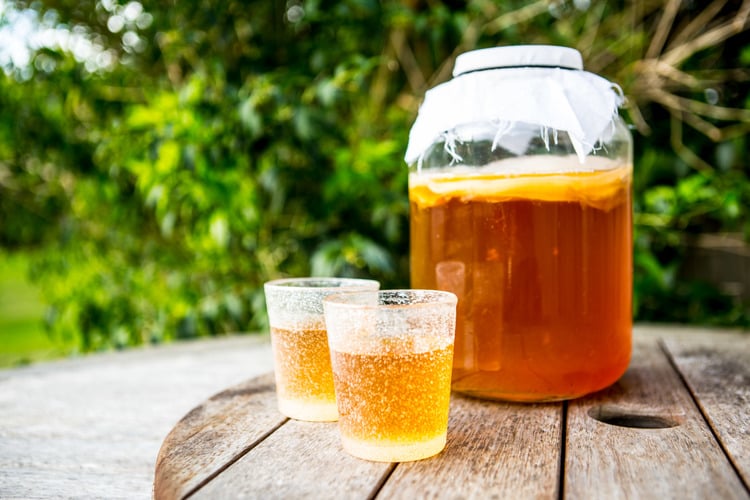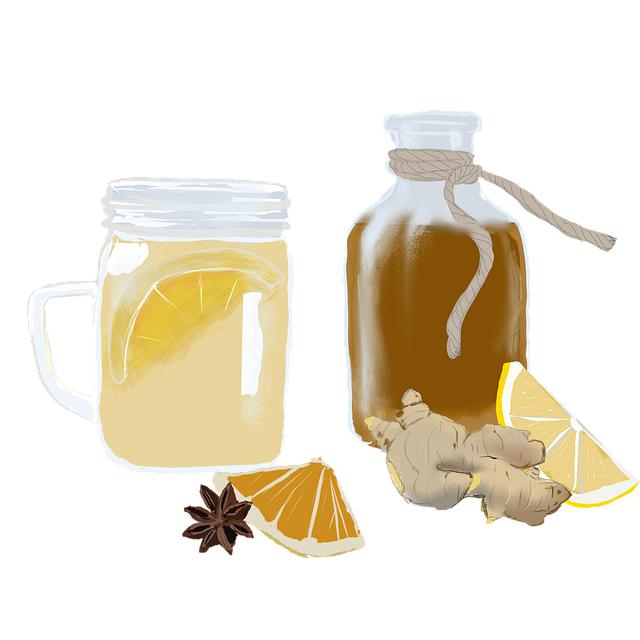Table of Contents
- Understanding the Essence of Kombucha and Its Origins
- Exploring the Health Benefits of Kombucha for Everyday Wellness
- The Brewing Process: A Step-by-Step Guide to Creating Your Own Kombucha
- Choosing the Right Kombucha: What to Look for in Quality Brands
- Incorporating Kombucha into Your Lifestyle: Tips and Recipes for Enjoyment
- Q&A
- The Way Forward
Understanding the Essence of Kombucha and Its Origins
Kombucha is more than just a trendy beverage; it’s a living elixir steeped in history and culture. This fermented drink originated around 2000 years ago in Northeast China, where it was revered for its supposed health benefits and rejuvenating properties. Known as the “Tea of Immortality,” kombucha was traditionally brewed using sweetened black or green tea, and it’s the remarkable fermentation process that sets it apart, resulting in its characteristic fizzy texture and tangy flavor.
The brewing of kombucha involves a symbiotic culture of bacteria and yeast (often abbreviated as SCOBY). This culture transforms the tea into a probiotic-rich beverage through fermentation, producing beneficial acids, enzymes, and vitamins. The fermentation process typically lasts anywhere from one to three weeks, during which time the drink develops its distinctive flavors. The taste can vary significantly, influenced by factors such as the type of tea used, the fermentation duration, and any added flavorings like fruits or herbs. Common flavor profiles include:
- Sweet and tart: A balance of sugar and acidity, often enhanced with citrus fruits.
- Herbal: Infusions of mint, chamomile, or other herbs for a refreshing twist.
- Spicy: Ingredients like ginger or turmeric can add warmth and depth.
Historically, kombucha was utilized not only as a beverage but also as a tonic believed to promote wellness and longevity. Its introduction into Europe in the early 20th century further solidified its reputation, as it began to attract attention from health enthusiasts and the wellness community. Today, kombucha is enjoyed worldwide and has evolved into a versatile drink that can be found in various flavors, brands, and brewing methods. Interestingly, the rise in kombucha’s popularity has ignited a renewed interest in fermentation and traditional food practices, illustrating the timeless appeal of this ancient brew.


Exploring the Health Benefits of Kombucha for Everyday Wellness
Kombucha is a fermented tea that has recently gained popularity for its numerous health benefits. This effervescent drink is created by fermenting sweetened tea with a symbiotic culture of bacteria and yeast known as a SCOBY. Rich in probiotics, kombucha supports gut health by encouraging a diverse microbiome, which is crucial for effective digestion and nutrient absorption. Studies suggest that a healthier gut can lead to enhanced immunity and overall well-being.
Moreover, kombucha is packed with antioxidants, which can combat oxidative stress in the body. By reducing free radicals, these antioxidants may reduce the risk of chronic diseases and promote longevity. Additionally, this fermented drink can aid in detoxification, as it contains glucaric acid, which supports liver function and helps eliminate toxins. The potential benefits of kombucha extend beyond gut health, as it also promotes stronger nails, hair, and skin through its vitamin content, particularly B vitamins.
Here are some specific health benefits associated with consuming kombucha:
- Improved Digestion: Helps alleviate digestive issues such as bloating and constipation.
- Enhanced Mood: The probiotics in kombucha may contribute to better mental health and reduced anxiety.
- Weight Management: Low in calories and sugar, it can be a satisfying, low-calorie beverage option.
- Heart Health: Some studies indicate potential reductions in cholesterol levels.
| Benefit | Description |
|---|---|
| Gut Health | Boosts beneficial gut bacteria through fermentation. |
| Detoxification | Supports liver health and toxin elimination. |
| Energy Levels | May improve energy due to the presence of B vitamins. |


The Brewing Process: A Step-by-Step Guide to Creating Your Own Kombucha
Creating your own kombucha is both an art and a science, blending the right ingredients with patience and care. To get started, gather your supplies: the essential ingredients include black or green tea, sugar, a SCOBY (Symbiotic Culture of Bacteria and Yeast), and filtered water. Your equipment should consist of a large glass jar, a cloth or paper towel, and rubber bands. Choosing a clean and sanitized environment is crucial, as it helps prevent contamination during the brewing process.
Once you have everything prepared, follow these crucial steps:
- Brew your tea: Start by boiling about 4 cups of filtered water, then steep your chosen tea for 5-15 minutes, depending on the intensity of flavor desired.
- Dissolve the sugar: While the tea is still warm, mix in 1 cup of sugar until it is completely dissolved.
- Cool the mixture: Add another 4 cups of filtered water to cool down the sweet tea to room temperature.
- Add the SCOBY: Once the sweetened tea is cooled, pour it into your glass jar, and gently place the SCOBY on top.
- Cover and ferment: Cover the jar with the cloth, securing it with a rubber band, and place it in a warm, dark location for about 7-14 days, checking for taste periodically.
During the fermentation period, the SCOBY will consume the sugar and convert it into various acids, gases, and a hint of fizz, resulting in the tangy and effervescent brew you aim for. The duration of fermentation significantly influences the flavor and acidity of your kombucha, so feel free to experiment! After reaching your preferred taste, you can remove the SCOBY and save it for your next batch. You may also want to add flavors like fruits, herbs, or spices during this stage. Once bottling, remember to strain out any sediment, seal the bottles tightly, and allow them to carbonate for a few more days at room temperature before refrigerating them for enjoyment.


Choosing the Right Kombucha: What to Look for in Quality Brands
When exploring the world of kombucha, it’s essential to understand what distinguishes quality brands from the rest. Not all kombucha is created equal, and a few key ingredients can make a significant difference. First, look for those made with high-quality, organic teas. The base of your kombucha plays a crucial role, as the flavor profile and health benefits stem from this starting point. Additionally, you should seek brands that use real fruit and spices for flavoring rather than artificial additives.
Another important factor to consider is the fermentation process. Quality brands will often provide transparency about their brewing methods, which typically involve longer fermentation times to enhance flavor and probiotic content. Check the bottles for details on the fermentation period and whether they undergo secondary fermentation. The resulting fizz and depth of flavor can greatly influence your kombucha enjoyment and health benefits. Furthermore, be sure to choose brands that do not over-filter their kombucha, as this could strip away some beneficial bacterias.
pay attention to the sugar content and nutritional information of the kombucha. While a certain level of sugar is normal, especially when flavors are added, avoid brands laden with excessive sugars. A good kombucha should ideally have between 2 to 6 grams of sugar per serving. To help you assess your choices better, here’s a quick comparison table for common kombucha brands:
| Brand | Sugar Content (per 8 oz) | Organic Ingredients | Fermentation Time |
|---|---|---|---|
| Kombucha Wonder Drink | 4g | Yes | 14 days |
| GT’s Kombucha | 5g | Yes | 30 days |
| Health-Ade | 2g | Yes | 15 days |
| Brew Dr. Kombucha | 3g | Yes | 14 days |
Choosing the right kombucha can greatly enhance your experience and maximize the health benefits you receive. By focusing on organic ingredients, appropriate fermentation times, and manageable sugar levels, you’ll ensure that your kombucha is not only delicious but also nourishing for your body.


Incorporating Kombucha into Your Lifestyle: Tips and Recipes for Enjoyment
Integrating kombucha into your daily routine can be both enjoyable and beneficial. Whether you’re a seasoned kombucha fan or just starting your healthy beverage journey, the versatility of kombucha makes it easy to incorporate into meals and snacks. Start by replacing sugary drinks with kombucha during meals; its tangy flavor pairs well with various dishes. For instance, consider enjoying it with salads or grilled vegetables, where the acidity of the kombucha complements the freshness of the ingredients.
Another delightful way to incorporate this effervescent drink is by using it in creative recipes. You can create a refreshing kombucha smoothie for breakfast or a post-workout boost. Blend your favorite fruits like berries or mango with a cup of kombucha, some spinach, and a scoop of protein powder for an energizing start to your day. Additionally, kombucha can serve as an intriguing base for cocktails or mocktails; just mix it with fresh herbs, citrus, and ice for a bubbly refreshment that will impress your guests.
When it comes to homemade recipes, brewing your own kombucha can be a rewarding and fun experience. Start with basic ingredients: tea, sugar, and a SCOBY (Symbiotic Culture Of Bacteria and Yeast). Below is a simple table of the essentials you’ll need:
| Ingredients | Quantity |
|---|---|
| Water | 1 gallon |
| Tea (black or green) | 5-8 bags |
| Sugar | 1 cup |
| SCOBY | 1 piece |
| Starter kombucha | 1 cup |
By following a simple process of brewing, fermenting, and flavoring, you can create delicious customized kombucha flavors that fit your personal taste. The possibilities are infinite—experiment with spices, fruits, and herbs for a unique touch that transforms your health drink into an exciting experience.
